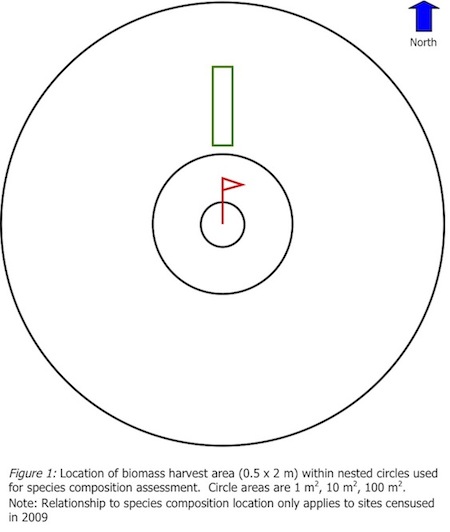Aboveground Net Primary Productivity- GLBRC Extensive Sites
Retired
In use from 2009-01-01 to 2010-12-31
Abstract
Background:
Aboveground net primary productivity (ANPP) and species/category abundance is measured by harvesting the aboveground standing biomass and surface litter within a 1 m2 area. Current year’s biomass is sorted and bagged by species/category in the field. Surface litter was collected and bagged.
Robel pole assessments of plant density in prairie and switchgrass fields are done in four cardinal directions from the center of the harvested area before clipping begins. See Robel Pole method.
Protocol
Materials & Equipment:
Clippers
Sharpie markers
Brown Kraft Paper Bags, various sizes
PVC frame, inner dimension 2 meters x 0.5 meters
Forced air oven
Balance accurate to 0.01 grams.
Method:
1. Use the long side of the frame to measure two meters north from the plot flag. Position the 0.5 × 2 meter frame with the long side extending north. The frame is worked through the standing plants to the ground surface such that no plant stems rooted outside of the 1 m2 area are lying inside the frame.
2. The plants rooted within the frame are clipped at ground level, sorted by the following species/categories, and bagged:
Andropogon gerardii (ANOGE)
Panicum virgatum (PANVI)
Sorghastrum nutans (SOSNU)
Corn
Other grasses
Forbs
3. Surface litter (SURFL) within the m2 area is collected after harvesting the standing plant material. Clip around the inside of the frame and collect the litter, avoid collecting soil with litter.
4. Harvested material is dried in a forced-air oven at 150°F for a minimum of 72 hours.
5. Dried plant material is weighed to 0.01 grams.

Corn Site Method Notes:
The frame is oriented perpendicular to the corn rows. This allows for assessment of the row and inter-row community. The frame is placed north of the flag in fields with east-west row orientation. In fields with north-south rows, the frame is place east of the flag. The frame is centered so that the distance on both ends is approximately half of the total inter-row distance. The number of crop rows within the frame depends on the inter-row spacing—in practice this is usually three corn rows, but occasionally it is two. The number of plants harvested is recorded. Robel pole assessments are not done in the corn sites.
Date modified: Tuesday, Oct 24 2023
Datatables
- Plant Biomass (KBS080-002)
- Plant Biomass in the Extensive Sites (GLBRC080-002)
In 2008 plants were sorted to species.
This protocol plants are sorted to the 3 big grass spp (ANOGE, PANVI, SOSNU), other grass, forbs, litter.
2/15/2023 JS retired protocol
